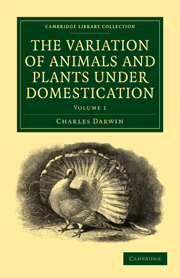Book contents
- Frontmatter
- Contents
- LIST OF ILLUSTRATIONS
- INTRODUCTION
- CHAPTER I DOMESTIC DOGS AND CATS
- CHAPTER II HORSES AND ASSES
- CHAPTER III PIGS — CATTLE — SHEEP — GOATS
- CHAPTER IV DOMESTIC RABBITS
- CHAPTER V DOMESTIC PIGEONS
- CHAPTER VI PIGEONS—continued
- CHAPTER VII FOWLS
- CHAPTER VIII DUCKS — GOOSE — PEACOCK — TURKEY — GUINEA-FOWL — CANARY-BIRD — GOLD-FISH — HIVE-BEES—SILK-MOTHS
- CHAPTER IX CULTIVATED PLANTS: CEREAL AND CULINARY PLANTS
- CHAPTER X PLANTS continued — FRUITS — ORNAMENTAL TREES — FLOWERS
- CHAPTER XI ON BUD-VARIATION, AND ON CERTAIN ANOMALOUS MODES OF REPRODUCTION AND VARIATION
CHAPTER VIII - DUCKS — GOOSE — PEACOCK — TURKEY — GUINEA-FOWL — CANARY-BIRD — GOLD-FISH — HIVE-BEES—SILK-MOTHS
Published online by Cambridge University Press: 05 October 2010
- Frontmatter
- Contents
- LIST OF ILLUSTRATIONS
- INTRODUCTION
- CHAPTER I DOMESTIC DOGS AND CATS
- CHAPTER II HORSES AND ASSES
- CHAPTER III PIGS — CATTLE — SHEEP — GOATS
- CHAPTER IV DOMESTIC RABBITS
- CHAPTER V DOMESTIC PIGEONS
- CHAPTER VI PIGEONS—continued
- CHAPTER VII FOWLS
- CHAPTER VIII DUCKS — GOOSE — PEACOCK — TURKEY — GUINEA-FOWL — CANARY-BIRD — GOLD-FISH — HIVE-BEES—SILK-MOTHS
- CHAPTER IX CULTIVATED PLANTS: CEREAL AND CULINARY PLANTS
- CHAPTER X PLANTS continued — FRUITS — ORNAMENTAL TREES — FLOWERS
- CHAPTER XI ON BUD-VARIATION, AND ON CERTAIN ANOMALOUS MODES OF REPRODUCTION AND VARIATION
Summary
I will, as in previous cases, first briefly describe the chief domestic breeds of the duck:—
Breed 1. Common Domestic Duck.—Varies much in colour and in proportions, and differs in instincts and disposition from the wild-duck. There are several sub-breeds:—(1) The Aylesbury, of great size, white, with paleyellow beak and legs; abdominal sack largely developed. (2) The Rouen, of great size, coloured like the wild-duck, with green or mottled beak; abdominal sack largely developed. (3) Tufted Duck, with a large topknot of fine downy feathers, supported on a fleshy mass, with the skull perforated beneath. The top-knot in a duck which I imported from Holland was two and a half inches in diameter. (4) Labrador (or Canadian, or Buenos Ayres, or East Indian); plumage entirely black; beak broader, relatively to its length, than in the wild-duck; eggs slightly tinted with black. This sub-breed perhaps ought to be ranked as a breed; it includes two sub-varieties, one as large as the common domestic duck, which I have kept alive, and the other smaller and often capable of flight. I presume it is this latter sub-variety which has been described in France as flying well, being rather wild, and when cooked having the flavour of the wildduck; nevertheless this sub-variety is polygamous, like other domesticated ducks and unlike the wild duck. […]
- Type
- Chapter
- Information
- The Variation of Animals and Plants under Domestication , pp. 276 - 304Publisher: Cambridge University PressPrint publication year: 2010First published in: 1868



